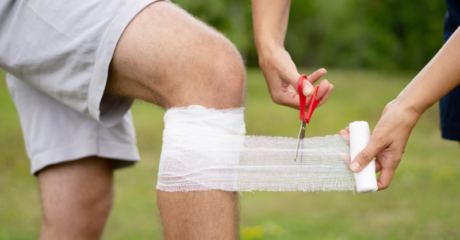
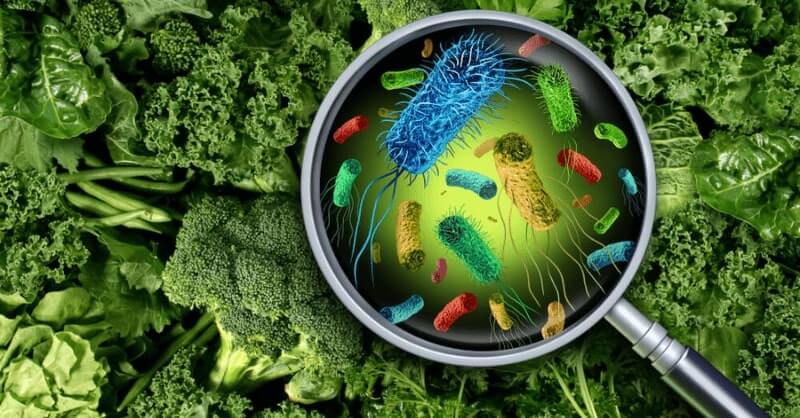
Food contamination- the term is very familiar to us. Is that a matter of concern? Let’s discover and understand it with a bunch of examples. Food contamination is a serious issue that can lead to various health problems, ranging from mild illnesses to life-threatening conditions.
There are four main types of food contamination: Physical, Chemical, Biological, and Allergenic Contamination. Additionally, each type of contamination can occur at different stages in food production and preparation, and consumers need to be aware of the risks associated with each class.
In this blog, we will explore each type of food contamination in detail and provide examples to help you understand how to prevent them. By understanding the different kinds of food contamination, you can take steps to protect yourself and your loved ones from the potential dangers of contaminated food.
What you will learn in this blog-
Table of Contents
What is Contamination?
Contamination refers to the presence of harmful or undesirable substances in a material or environment, which can affect its safety, purity, or quality.
Additionally, contamination is any unwanted pollution of something in another sense. When a nuclear power plant leaks radiation into the atmosphere, for example, it causes contamination of the surrounding area.
What is Food Contamination?
A contaminant is any substance that has been added to food that should not be there. Food contamination refers to the presence of harmful substances or disease-causing microorganisms in food that can cause illness or injury when consumed. Contaminants can include physical, chemical, or biological substances introduced into the food during any stage of its production, processing, storage, or distribution.
In other words, food contamination is generally defined as spoiled or tainted food due to microorganisms, such as parasites, bacteria or toxic substances that make them unfit for consumption. Contaminants can be biological, chemical, or physical, with the biological type being more common.

What is the Impact of Food Contamination?
Therefore, food can be accidentally or intentionally contaminated, with contaminated food posing a severe risk to the consumer. The impact of food contamination can range from mild illness to severe or life-threatening conditions, depending on the type and amount of contaminant present. Contaminated food can cause symptoms such as nausea, vomiting, diarrhoea, fever, and abdominal pain.
In severe cases, it can lead to hospitalisation or death. Food contamination can also result in economic losses for the food industry, damage to brand reputation, and loss of consumer confidence.
What are the Four Types of Food Contamination?
Food manufacturers must do everything possible to prevent contamination and produce safe products. There are four types of food contamination: physical, biological, chemical and allergenic.
One: Chemical Contamination
This type of contamination occurs when harmful chemicals enter a food. Chemical contaminants, such as toxins produced by moulds or plants, can naturally occur or come from external sources like pesticides, cleaning products, or food packaging materials.
Examples of chemical contaminants include:
- Heavy metals (e.g., iron, lead, cadmium).
- Environmental pollutants (e.g., dioxins, PCBs).
- Food additives (e.g., nitrates, sulfites).
How to Prevent Contamination Chemical Contamination of Food
Chemical contamination of food can be a severe health hazard, but there are steps you can take to avoid or prevent it. First, it’s important to store chemicals properly in a separate area from food and use them as directed while following all safety precautions.
Besides, wash your hands before handling food and keep food preparation areas clean and sanitized. It’s also essential to purchase food from reputable sources and check for any signs of contamination before using it.
Second: Avoid using pesticides or chemicals near food preparation or storage areas, and follow proper food storage guidelines, including using airtight containers and storing at appropriate temperatures.
Finally, follow good cooking and reheating guidelines to ensure your food is safe. By following these steps, you can significantly reduce the risk of chemical contamination in your food and protect your health.
Two: Microbial Contamination
This type of contamination happens when food becomes contaminated with harmful microorganisms, including bacteria, viruses, or parasites. These microorganisms can grow and multiply in food, leading to foodborne illnesses like salmonellosis, listeriosis, or norovirus. Familiar sources of microbial contamination include raw or undercooked meats, raw produce, and contaminated water.
For example:
- Undercooking chicken can give rise to campylobacter bacteria.
- While rearing and slaughtering animals, the salmonella that lives in animal intestines can transfer onto food products.
- Storing and preparing high-risk raw foods close to ready-to-eat food can lead to cross-contamination.
- Fish and shellfish may eat toxic-producing organisms that are dangerous to humans if they eat them.
How to Prevent Microbial Contamination
To prevent microbial contamination of food, it is crucial to practice good hand hygiene, handle and store food properly, regularly clean and sanitize surfaces and utensils, refrigerate foods at the appropriate temperature, and provide education and training for food handlers.
In addition, it is essential to monitor and test food products for microbial contamination regularly and to dispose of any contaminated or expired products properly. Implementing these measures and being vigilant about food safety can reduce the risk of foodborne illnesses and ensure that the food served is safe for consumption.
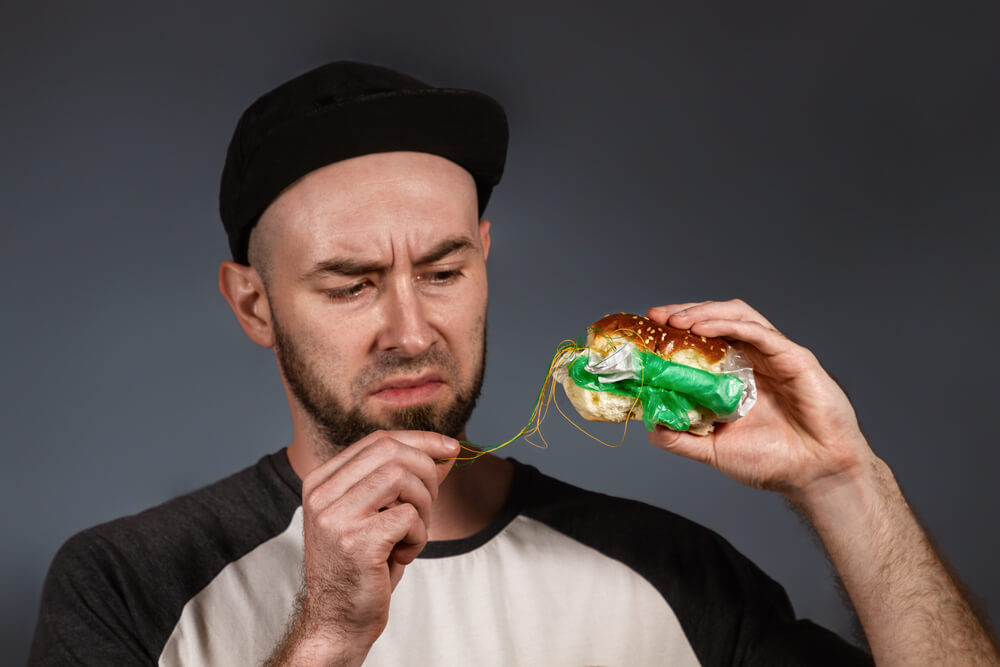
Three: Physical Contamination
This contamination occurs when foreign objects like glass, metal, plastic, or hair get into food. This can happen during food processing, packaging, or handling. Physical contaminants can cause injury or illness, especially if they are sharp or toxic.
For example,
- Hair, bandages, fingernails, jewellery, broken glass, metal, paint flakes, bone, the body parts of pests, or pest droppings.
- Metal shavings from food processing equipment can cause cuts, choking or wounds.
How to Prevent Physical Contamination
Physical contamination of food can occur in many ways, such as through contact with foreign objects like hair or glass. The best way to minimise the chance of a physical contaminant is to provide continuing education and training to all staff and a hygienic and clean environment for staff to work in. To prevent physical contamination, it is essential to follow some basic guidelines.
First, food handlers should always practice good hygiene by washing their hands thoroughly and wearing appropriate clothing, such as hairnets or hats. This helps to prevent any physical contaminants from being introduced to the food.
Second, it is crucial to properly store and handle food products. This includes keeping raw meats and vegetables separate to prevent cross-contamination and adequately packaging and storing food items to avoid exposure to foreign objects.
Third, it is essential to regularly inspect food preparation and service areas for any signs of physical contamination. This includes checking utensils and equipment for cracks or other signs of wear and tear that could introduce biological contaminants to the food.
Finally, food handlers should be adequately trained in safety and handling procedures. This can help to prevent physical contamination by ensuring that everyone working with food understands the importance of good hygiene and proper food handling practices.
By following these guidelines, it is possible to prevent physical contamination and ensure that the food served is safe for consumption.
Four: Allergenic Contamination
This type of contamination occurs when food is contaminated with allergens, which are proteins that can cause an allergic reaction in some people. In addition, allergenic contamination can happen when an allergen is unintentionally added to a food product, such as through cross-contact during manufacturing or packaging.
This can be dangerous for people with severe food allergies, as even small amounts of an allergen can trigger a life-threatening allergic reaction called anaphylaxis.
Examples: Common food allergens include peanuts, tree nuts, milk, eggs, soy, wheat, fish, and shellfish.
How to Prevent Allergenic Contamination of Food
To avoid/prevent allergenic contamination of food, it is essential to take measures such as proper labelling of food products, maintaining good hygiene and sanitation practices, separating allergenic ingredients from non-allergenic ones, educating and training staff, and communicating with customers.
It is also essential to know the most common allergens, such as peanuts, tree nuts, milk, eggs, fish, shellfish, soy, and wheat. These allergens should be handled with extra care to prevent cross-contact and contamination.
In addition, food businesses should have a plan to respond to allergic reactions in an emergency. By implementing these preventive measures, companies can create a safe environment for individuals with food allergies to enjoy their meals with peace of mind.
By following these measures, the risk of allergic reactions to food can be reduced, and individuals with food allergies can safely enjoy a variety of foods.
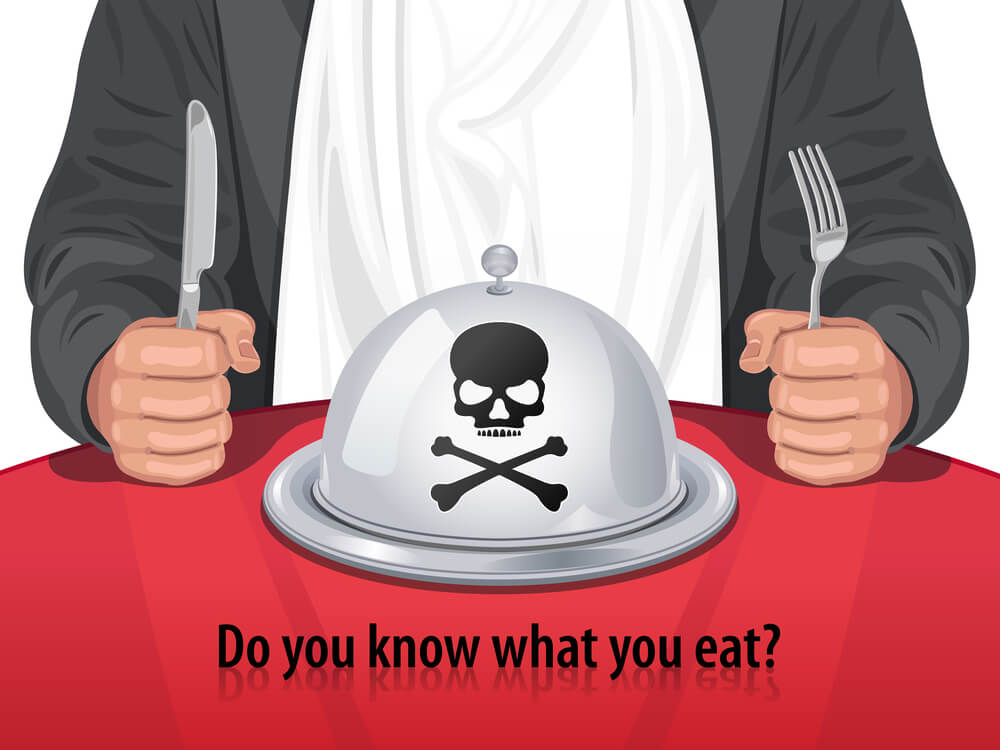
Cross-Contamination
Cross-contamination is the transfer of harmful bacteria or other pathogens from one surface, object, or food item to another. Moreover, it can occur through direct contacts, such as when raw meat touches cooked or ready-to-eat food, or indirect contact, such as when a contaminated utensil or surface touches another food item.
Besides, cross-contamination is a significant concern in food preparation, as it can spread harmful bacteria, such as E. coli, Salmonella, and Listeria. These bacteria can cause foodborne illnesses, ranging from mild to severe, and in some cases, can be life-threatening.
To prevent cross-contamination, it is essential to follow proper food handling practices. This includes washing hands frequently, sanitizing surfaces and equipment, keeping raw meats separate from other food items, using separate cutting boards and utensils for different food items, and cooking food to the appropriate temperature.

Food Poisoning
Food poisoning is a condition that occurs when a person consumes food or drinks that are contaminated with harmful bacteria, viruses, parasites, or toxins.
Notably, the symptoms of food poisoning can vary from mild to severe and appear within a few hours to several days after consuming the contaminated food or drink.
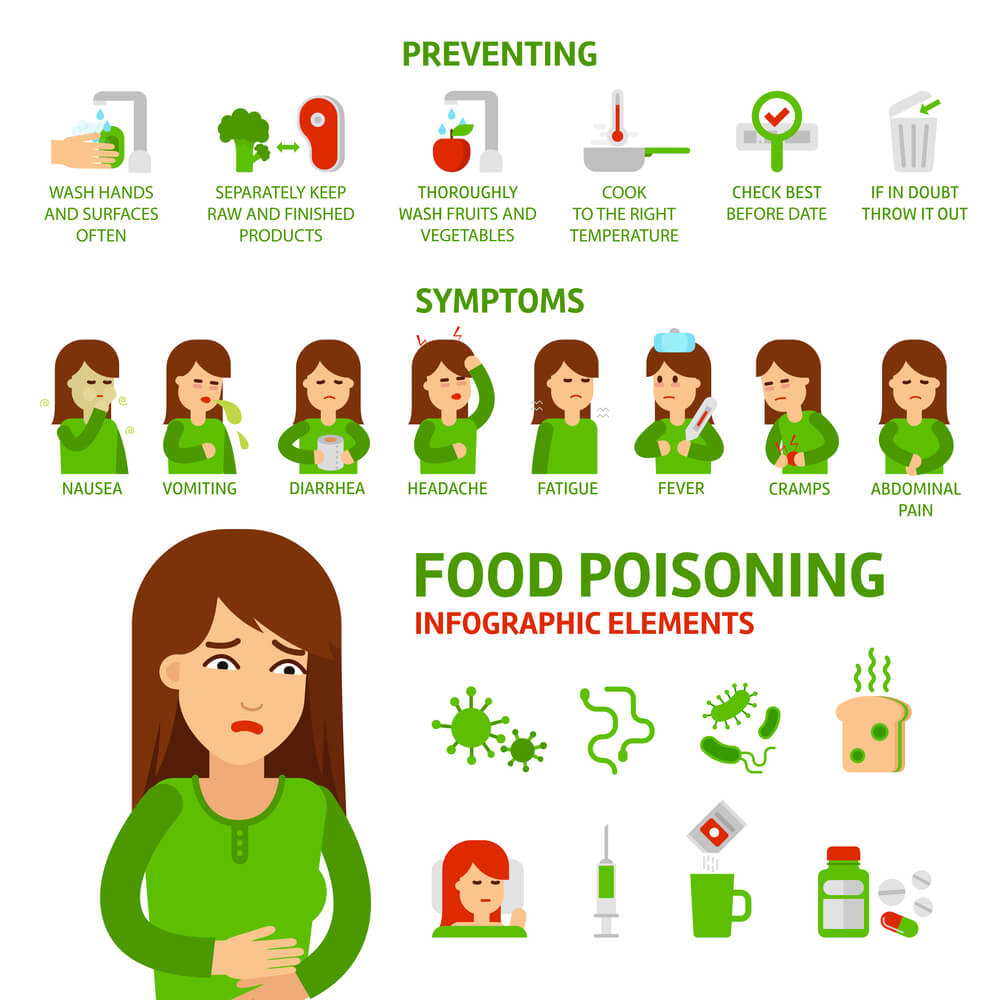
Sign and Symptoms
The severity and duration of food poisoning symptoms can vary depending on the type of contaminant and the individual’s overall health. In most cases, symptoms of food poisoning will resolve within a few days without treatment.
Some of the familiar signs and symptoms of food poisoning include:
- Loss of appetite
- Fever and chills
- Nausea and vomiting
- Abdominal pain and cramps
- Headache, weakness or fatigue
- Diarrhoea, which may be watery or bloody
- Dehydration may be characterized by dry mouth, dry skin, and decreased urination.
However, in severe cases, medical attention may be necessary to prevent complications such as dehydration, electrolyte imbalances, and organ damage.
How to Treat Food Contamination?
So how to treat food contamination? Actually, it depends on the cause and severity of the contamination. In most cases, food poisoning will resolve within a few days as the body eliminates the contaminants. However, several steps can be taken to help alleviate symptoms and promote recovery:
Rehydration: Drinking plenty of fluids, particularly water and electrolyte solutions, is essential to prevent dehydration and restore fluids and electrolytes lost due to diarrhoea and vomiting.
Medications: Over-the-counter medications such as anti-diarrheal agents and pain relievers can help alleviate symptoms such as diarrhoea, abdominal pain, and headache. However, it is essential to consult with a healthcare provider before taking any medication, particularly in the case of severe symptoms.
Nutritious Food: Once the acute symptoms have subsided, it is essential to eat small, frequent, and healthy meals to help the body regain strength and recover from the illness.
Rest: Resting and avoiding physical activity can help the body recover and reduce the risk of complications.
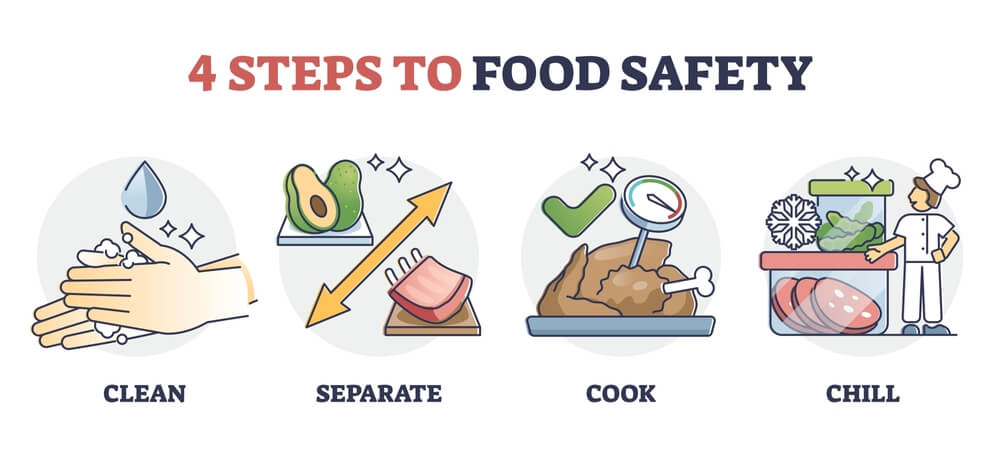
How Do You Stay Safe from Food Contamination?
There are several steps that you can take to stay safe from food contamination such as:
- Clean: Wash your hands frequently with soap and water before handling food and after using the restroom, taking pets, or changing diapers. Also, wash your fruits and vegetables thoroughly before eating or cooking.
- Separate: Keep raw meat, poultry, seafood, and eggs different from other foods in your shopping cart, refrigerator, and during food preparation.
- Cook: Use a food thermometer to ensure that meats, poultry, seafood, and eggs are cooked to the appropriate temperature to kill harmful bacteria. It is essential to cook minced beef to an internal temperature of 160°F (71°C) and chicken and turkey at 165°F (74°C).
- Chill: Refrigerate perishable foods within 2 hours of purchasing or preparing, and use them within the recommended timeframe. The temperature of your refrigerator should be below 40°F (4°C).
In addition, you can choose restaurants with a good reputation for food safety, and avoid eating raw or undercooked meat, fish, or eggs.
What are High-Risk Foods?
High-risk foods require special care in handling, storage, and preparation to minimise the risk of contamination. If in doubt, seek advice from a food safety expert or trusted source. High-risk foods in the UK refer to those that are more likely to cause foodborne illnesses. For example:
- Cooked meat and poultry.
- Ready-made pies and pasties.
- Gravy, stock, sauces and soup.
- Dairy products, cooked rice.
- Meat products such as pâté or stews.
- Raw egg products such as mayonnaise.
- Shellfish – particularly oysters, prawns and crabs.
Food Safety in Catering
Food safety in catering is crucial to prevent foodborne illnesses. Caterers should handle raw food separately from ready-to-eat food to evade cross-contamination with bacteria. Proper cleaning and sanitising of equipment and utensils are also essential to ensure food safety.
Additionally, caterers must purchase food from reputable sources, store food properly, and follow proper food handling techniques, such as washing hands frequently, wearing gloves, and sanitising surfaces and equipment. Furthermore, caterers should cook food to the appropriate temperature, keeping hot food at 140°F (60°C) or above and cold food at 40°F (4°C) or below.
What is the Danger Zone Temperature?
The danger zone temperature for food is the temperature range between 40°F (4°C) and 140°F (60°C), where harmful bacteria can grow and multiply rapidly, increasing the risk of foodborne illness.
To minimise the risk of foodborne illness, you should keep hot foods at a temperature of at least 140°F (60°C), while you need to keep cold foods at a temperature of 40°F (4°C) or below.
Additionally, foods should not be left in the danger zone for more than two hours or one hour if the temperature is above 90 °F (32 °C). Properly storing and preparing food can reduce the risk of foodborne illness and keep food safe.
Who is at a Higher Risk of Food Poisoning?
Individuals with weakened immune systems, such as adults aged 65 and older, children younger than five years, and people whose immune systems are weakened due to illness or medical treatment, pregnant women are at a higher risk of food poisoning.
People taking medications that suppress their immune system are also at a higher risk. To reduce the risk of food poisoning, these individuals should take extra precautions when handling, preparing, and consuming foods.
Summary
Food safety is essential to ensuring public health and preventing foodborne illnesses caused by various types of contamination. The four main types of food contamination are physical, chemical, biological, and allergenic. To overcome food contamination, it is crucial to take appropriate measures at all stages of the food production process, from sourcing raw materials to cooking, storage, and serving.
Other measures to help prevent food contamination include training employees on proper food handling procedures, regular cleaning and sanitation of food preparation and storage areas, and maintaining accurate temperature control during storage and transportation.
You can also check our Food Hygiene and Safety Level 3 course to get a deeper understanding from our industry-leading experts.
FAQ
What is the most common source of contamination?
The most common source of contamination is biological contamination caused by harmful microorganisms like bacteria, viruses, or parasites.
Which is natural source of contamination?
Natural sources of contamination include soil, water, air, and animals or plants that come into contact with food during production.
Is food contamination a crime?
Food contamination can be a criminal offence if done intentionally to harm consumers or violate food safety regulations. However, not all instances of contamination are illegal.
What is the process of contamination?
The method of contamination involves the introduction of harmful substances, such as microorganisms, chemicals, or foreign objects, into food. This can occur at any stage of the food production process, from sourcing raw materials to processing, cooking, storage, and serving.
Therefore, preventing contamination requires a multi-step approach that includes proper handling, storage, and sanitation practices.
- Available Courses
- Career Bundles73
- Animal care5
- Law8
- Quality Licence Scheme Endorsed111
- Teaching13
- Teaching & Academics Primary27
- Accounting & Finance Primary30
- Training3
- Design14
- IT & Software84
- Healthcare126
- Marketing31
- Health and Safety403
- Construction48
- Electronics25
- Hospitality22
- Health and Social Care219
- Child Psychology37
- Management377
- Business Skills268
- First Aid70
- Employability264
- Safeguarding75
- Food Hygiene103
- Personal Development1309
 Food Hygiene
Food Hygiene Health & Safety
Health & Safety Safeguarding
Safeguarding First Aid
First Aid Business Skills
Business Skills Personal Development
Personal Development







